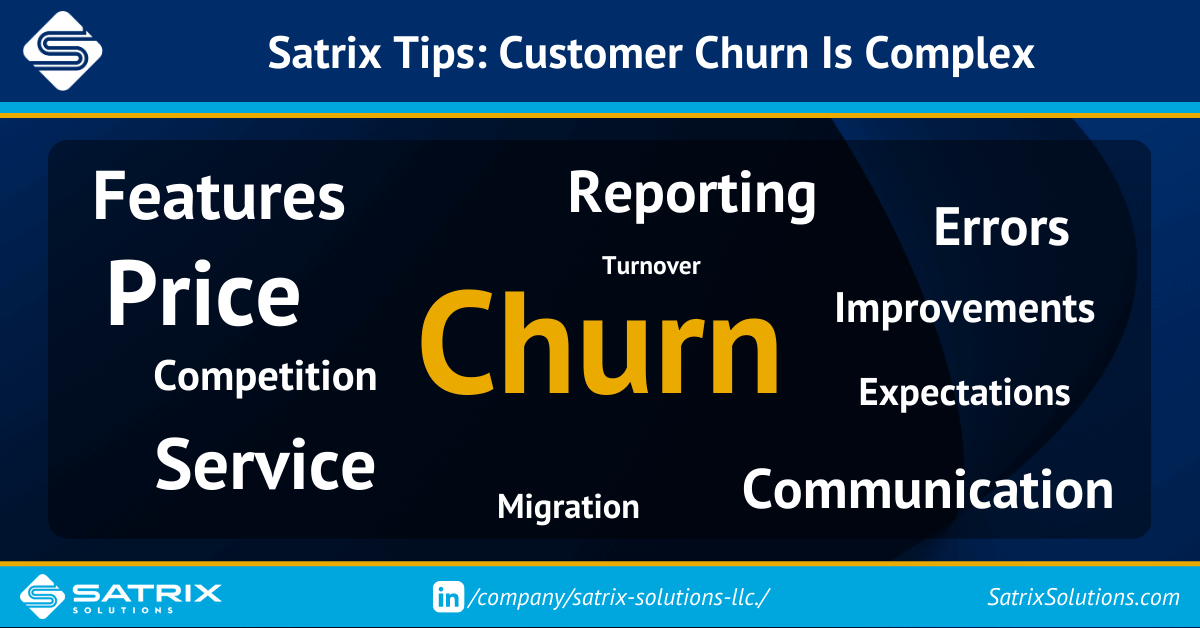Oversimplification of Churn
There seems to be a growing segment of “experts” striving to reduce complicated situations into overly simple constructs. I’ve read a few customer experience (CX) related articles recently in which the author seems to go out of their way to make something quite complex seem simple. I've read generalizations like:
“B2B customers churn because they aren’t getting value.”
“Your company is losing sales deals because you haven’t effectively conveyed to the prospect why your solution is better.”
“Renewals decline because you have a problem with product adoption.”
The Complexities Of Churn
At Satrix Solutions, we conduct hundreds of interviews and field even more surveys to understand precisely why customers churn, what drives customer satisfaction, and why buyers select one vendor over another. The reasons are almost always multifaceted and require extensive analysis and probing to understand completely. Some of the common pieces to the churn puzzle are:
-
Common Churn Factors
- Feature gaps compared to alternatives
- License fees too high
- Frustrations with migrating to a new platform
- Poor responsiveness from the account rep
- Misled by the sales team
Generalization of Value
Maybe the drivers of satisfaction or churn can be generalized to all fall under the umbrella of “value,” but how helpful is that to a leadership team that wants to take action to address specific gaps or pain points? And yes - there are some cases when the customer’s decision is straightforward and one-dimensional, such as procurement selecting the lowest price solution or losing an account after your champion left the organization. But I can confidently say those are more the exception than the rule.
Churn Analysis Example
Let me share some context with an example. In managing a Churn Analysis Program for a SaaS and Service client, we aggregated the feedback we received from interviewing decision-makers across dozens of their churned accounts. These interviews, usually about 30 minutes, took place over 12 months and were summarized for a quarterly readout with leadership and an annual deep dive for their end-of-year planning offsite. After conducting each in-depth interview, we systematically identified all factors that led each customer to take their business elsewhere. They are summarized in the following table (in no particular order):
-
Churn Drivers
- Frustrations with migrating to the new platform
- Rigid company policies
- Poor responsiveness from the account rep
- Implementation took longer than expected
- License fees too high
- Nickle & diming
- Too many mistakes / errors
- Misled by the sales team
- High turnover on the service team
- Support team unable to resolve issues
- Inadequate reporting functionality
- Too many manual processes
- Competitor offered simpler pricing
- Feature gaps compared to alternatives
- Poor / antiquated UI
- Few customer feedback-driven improvements
- Company is too siloed
- Little visibility into the product roadmap
- Unsatisfactory training
- No attention from higher-ups, despite escalations
While the weightings and counts of each pain point are not shown, you can see that there can be dozens of reasons customers cite why they churn, switch to a competitor, and may even be compelled to share a negative review online. Each of these outcomes has the potential to damage your organization’s reputation and impede growth. That’s why it’s essential to pinpoint the precise reasons customers behave the way they do. Without this level of granularity, it’s profoundly difficult to prioritize corrective action and mitigate systemic issues.
Platitudes such as “deliver more value” are good for LinkedIn posts, but it’s dangerous to overly simplify complex challenges (like churn) that many companies face. Getting the complete picture requires time, expertise, and investment. However, business leaders can act accordingly when they understand the drivers of satisfaction and frustration. Such actions enable an organization to preemptively address other customers' issues or identify what success looks like so it can be replicated. That’s when the financial payoff becomes substantial.

